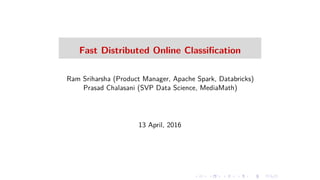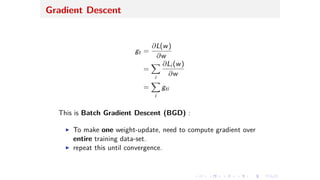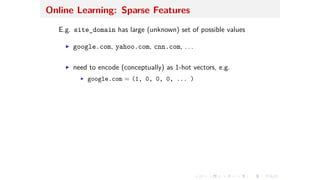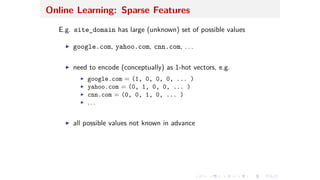The document describes a fast, scalable, online, distributed machine learning classifier built on Apache Spark. It leverages recent research to develop a classifier that can handle large, sparse datasets with up to hundreds of millions of features in a single pass. The system uses online learning techniques like stochastic gradient descent that allow incremental updates to the model as new data is received without requiring multiple passes over the training data. This makes it suitable for applications with streaming data where predictions are needed in real-time. Key challenges addressed include feature scaling, handling different feature frequencies, and efficiently encoding sparse features.



























































![Online Learning: Feature Scaling
But often:
I range of features not known in advance, and
I we cannot make a separate pass over the data to find ranges.
=∆ Need single-pass algorithms that
adaptively normalize features with each new observation.
[Ross,Mineiro,Langford 2013] proposed such an algorithm,
which we implemented in our online ML system.](https://image.slidesharecdn.com/april131610mediamathchalasaniv2-160425211204/85/Fast-Distributed-Online-Classification-60-320.jpg)








![Online Learning: Feature Frequency Di erences
Often, rare features much more predictive than frequent features.
Same learning rate for all features =∆ slow convergence.
=∆ rare features should have larger learning rates:
I bigger steps whenever a rare feature is seen
I much faster convergence
E ectively, the algo pays more attention to rare features
Enables finding rare but predictive features.
ADAGRAD is an algorithm for this [Duchi,Hazan,Singer 2010], and
we implemented this in our learning system.](https://image.slidesharecdn.com/april131610mediamathchalasaniv2-160425211204/85/Fast-Distributed-Online-Classification-69-320.jpg)





























